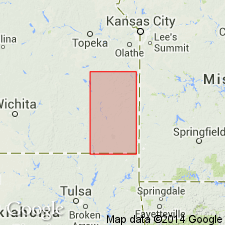
- Usage in publication:
-
- Tacket Formation
- Modifications:
-
- Named
- Dominant lithology:
-
- Shale
- Limestone
- AAPG geologic province:
-
- Cherokee basin
Summary:
Named as upper formation of Pleasanton Group for Tacket Mound in Parsons quad, SW sec 7, T32S, R19E, Labette Co., KS in the Cherokee basin. Type section south part Sec 7 and along west side Sec 17, T32S, R19E. Outcrop area southeast KS from Linn Co. to State line. Type section comprises two shale units separated by a limestone unit; lower shale is black, fissile, iron-stained at top, 20.5 ft thick; limestone unit nodular, gray, weathering light gray, very fine grained, conchoidal fracture, silty, 0.5 ft thick; upper unit is black shale, fissile, carbonaceous, contains phosphatic nodules near base, 19.0 ft thick. Is mostly carbonaceous and very dark gray to black shale, thin limestone layers interbedded with dark shale, and some sandstone in northern part. Thickness ranges from 15-60 ft. Lies between Checkerboard Limestone (below), and Critzer Member of Hertha Limestone (above). Overlies Seminole Formation in northern part of outcrop belt where Checkerboard is absent. Assigned a Late Pennsylvanian, early Missourian age.
Source: GNU records (USGS DDS-6; Denver GNULEX).
For more information, please contact Nancy Stamm, Geologic Names Committee Secretary.
Asterisk (*) indicates published by U.S. Geological Survey authors.
"No current usage" (†) implies that a name has been abandoned or has fallen into disuse. Former usage and, if known, replacement name given in parentheses ( ).
Slash (/) indicates name conflicts with nomenclatural guidelines (CSN, 1933; ACSN, 1961, 1970; NACSN, 1983, 2005, 2021). May be explained within brackets ([ ]).

